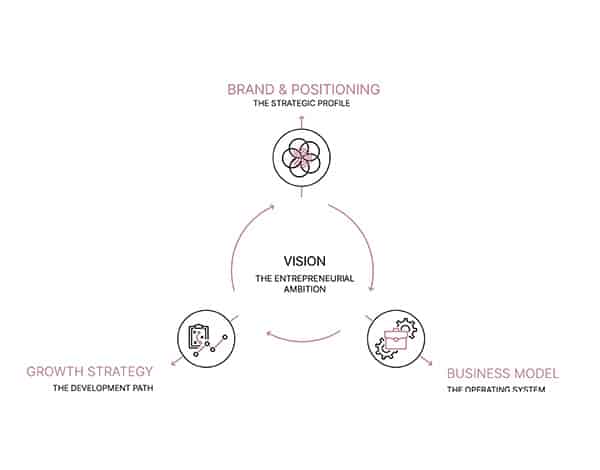Four building blocks for successfully shaping the future
Strategy is the shared vision of an attractive future and a clear plan for how organizations can achieve it. To be successful in this, four building blocks are required that are interdependent and mutually reinforcing: an ambitious entrepreneurial vision, attractive brand positioning, a well thought-out business model, and a clearly defined growth path. The IMARK strategy model combines all these building blocks to work systematically on these topics.
Through the entrepreneurial vision or the entrepreneurial aspiration, organizations paint their picture of the future and define where they want to go and what they want to achieve. The vision is a guideline for the entire company and describes the desired positive state of the organization in the future, i.e., what is to be brought about by the existence of the organization. As the overarching bracket for the brand & positioning, business model, and growth strategy, the vision is at the center of our model.
The brand positioning describes the strategic profile of the company and defines what the company should stand for. As with the company’s good reputation, it generates resonance and attractiveness on the market and ensures identification among employees. During the development of the brand profile, among other things, characteristics are defined that shape the personality and identity of the company. Furthermore, the central value propositions that are attractive to the core target groups are developed. The resulting brand profile is then translated into unique and differentiating benefits, products, and services.
The business model defines the value creation system in which organizations successfully position themselves to deliver value to the entire system based on their specific capabilities. This defines the areas of value creation in which organizations can contribute to generating benefits for customers and strategic partners and how they earn money in the process.
The growth strategy defines the development path that an organization sees for itself. To plan and achieve growth successfully, an organization needs to be clear about its own strengths and about the potential in its customer groups, services, and markets. Clear objectives in terms of growth and earnings help to realize this potential. The concretization of the growth path through partial steps, and the allocation of clear tasks and responsibilities helps to implement the defined growth strategy.
In addition to these four building blocks, a flexible, lively development process that integrates this content ensures the necessary clarity in management and among all employees in order to direct energy to the essentials. This results in clear images of the future that create sustainable orientation and focus and thus corporate success.
IMARK – Shaping the future through successful development processes




















